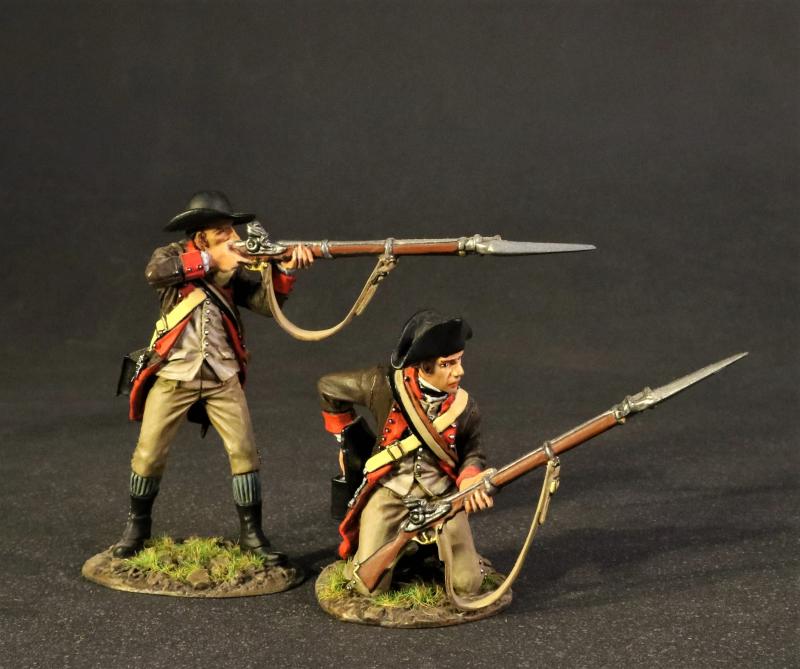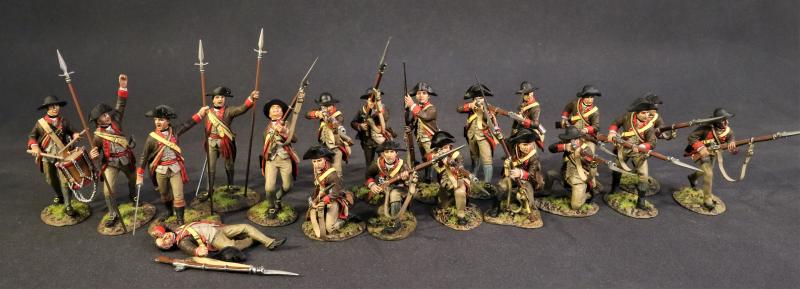Two Line Infantry (standing firing, kneeling loading), 12th Massachusetts Regiment, Continental Army, The Battle of Saratoga, 1777, Drums Along the Mohawk--two figures--RETIRED--LAST ONE!!
$80.00
Item Number: SMASS12-06
Two Line Infantry (standing firing, kneeling loading), 12th Massachusetts Regiment, Continental Army, The Battle of Saratoga, 1777, Drums Along the Mohawk
The surrender that changed the world”.
In October 1777, a 6,000 strong British army surrendered in defeat after the American victory at the Battles of Saratoga.
For the first time in history a British General surrendered his sword
Burgoyne's strategy to divide New England from the southern colonies had started well, but slowed due to logistical problems. He won a small tactical victory over General Horatio Gates and the Continental Army in the September 19 Battle of Freeman's Farm at the cost of significant casualties.
THE FIRST BATTLE OF SARATOGA 1777
THE BATTLE OF FREEMAN’S FARM, SEPTEMBER 19th 1777
THE CONTINENTAL ARMY
The Continental Army was formed by the Second Continental Congress after the outbreak of the American Revolutionary War by the colonies that became the United States of America. Established by a resolution of the Congress on June 14, 1775, it was created to coordinate the military efforts of the Thirteen Colonies in their revolt against the rule of Great Britain. The Continental Army was supplemented by local militias and troops that remained under control of the individual states or were otherwise independent. General George Washington was the commander-in-chief of the army throughout the war.
The Continental Army consisted of soldiers from all 13 colonies and, after 1776, from all 13 states. When the American Revolutionary War began at the Battles of Lexington and Concord on April 19, 1775, the colonial revolutionaries did not have an army. Previously, each colony had relied upon the militia, made up of part-time citizen-soldiers, for local defense, or the raising of temporary "provincial regiments" during specific crises such as the French and Indian War of 1754–63. As tensions with Great Britain increased in the years leading to the war, colonists began to reform their militias in preparation for the perceived potential conflict. Training of militiamen increased after the passage of the Intolerable Acts in 1774. Colonists such as Richard Henry Lee proposed forming a national militia force, but the First Continental Congress rejected the idea.
The Continental Army of 1777–80 evolved out of several critical reforms and political decisions that came about when it became apparent that the British were sending massive forces to put an end to the American Revolution. The Continental Congress passed the "Eighty-eight Battalion Resolve", ordering each state to contribute one-battalion regiments in proportion to their population, and Washington subsequently received authority to raise an additional 16 battalions. Enlistment terms extended to three years or to "the length of the war" to avoid the year-end crises that depleted forces (including the notable near-collapse of the army at the end of 1776, which could have ended the war in a Continental, or American, loss by forfeit)
THE 12th MASSACHUSETTS REGIMENT
The 12th Massachusetts Regiment, also known as the 18th Continental Regiment and Phinney’s Regiment was raised on April 23rd 1775, under Colonel Edmund Phinney outside of Boston Massachusetts. The regiment saw action at the Battle of Bunker Hill, Battle of Valcour Island, Battle of Saratoga and the Battle of Monmouth.
The regiment was disbanded on January 1st 1781, at West Point New York.
The brown coats with red facings was a popular uniform for American Continental Regiments, and these figures could represent several units for this period.
Released in APRIL 2021.
RETIRED.
LAST ONE!!

